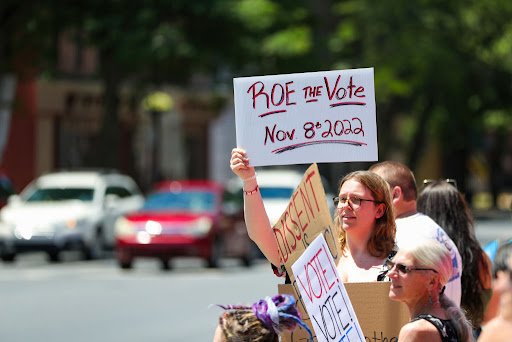Youth Voter Turnout Shatters Midterm Records
Protestors at an abortion rights rally in Bloomsburg, Pennsylvania on July 3rd, 2022. Source for photo: MsMagazine
In the 2022 midterm, Democrats defied the odds by adding a U.S. Senate seat to their majority, losing by far less than expected in the U.S. House of Representatives and making crucial gains in states like Pennsylvania and Michigan.
Looking at the country overall, 27% of young people (aged 18-29) turned out in the 2022 midterm elections, making up 13% of the overall electorate, according to day-after estimates from the Center for Information & Research on Civic Learning and Engagement (CIRCLE) at Tufts University. If young voter participation had increased to even just 50%, it could have been a much better night for Democrats, possibly allowing them to have kept control of the U.S. House of Representatives and not just the U.S. Senate.
This historically high turnout of young people, in a midterm election nonetheless, helped to carry Democrats across the finish line in many crucial races and states.
Looking at the possible motivations for this record turnout, there are multiple possibilities. Record turnout could be attributed to the policies Democrats’ chose to prioritize and campaign on such as climate change, social equality, and increased taxation on wealthier Americans to make sure they pay their “fair share.” It could also be a sign of the overall poor candidate quality of Republicans, giving young voters a reason to vote against Republicans, such as Gubernatorial candidates Tudor Dixon (R-MI), Kari Lake (R-AZ) and Doug Mastriano (R-PA) as well as Senate candidates Herschel Walker (R-GA) and Blake Masters (R-AZ). The three gubernatorial candidates, especially Lake, lost winnable races given the national political climate for Democrats, and the other two, Dixon and Mastriano, lost their races by double digits. In the same states that Dixon and Mastriano lost, Democrats gained control of at least one house in their respective state legislatures – Democrats flipped both the state house and state senate in Michigan, giving them full control of state government for the first time in 40 years.
These victories would not have been possible without the youth vote. Looking at the House of Representatives, voters aged 18-29 voted for Democrats in House of Representative contests by a margin of 63% for Democrats and 35% for Republicans, according to an exit poll conducted for ABC, CBS, NBC and CNN. This overwhelming victory allowed for the Democratic party to keep their losses small, leaving Republicans with only a 4-seat, potentially ungovernable, majority–given the level of disagreement and dissent within the Republican party. Even though Republicans do have this slim majority in the U.S. House of Representatives, youth voters aided greatly in the Democrats not only keeping their majority in the U.S. Senate, but adding one seat to it – thanks to John Fetterman (D-PA) winning his race – voters aged 18-29 voted for Fetterman by a margin of 70% in favor compared to 28% against.
Despite these victories, some activists are concerned about maintaining this strength with youth voters. “Burnout is a real concern when it comes to turning out each election. What I say to those disillusioned by the electoral process is that voting is a tool for change alongside a whole tool kit. In the times we’re living in, we must use every tool we have access to to protect and expand basic human rights because if we don’t, reactionary forces will prevail,” said TJ White, President of UNC Young Democrats. White adds, “I also like to remind young people of the material effects of voting. If young people didn’t vote in the first runoff in Georgia that sent Senator Raphael Warnock and Senator Jon Ossof to the US Senate there would be no child tax credit, there would be no stimulus check, there would be no Supreme Court Justice Ketanji Brown Jackson, there would be no Inflation Reduction Action. These outcomes are monumental and are only the result of young people heading to the polls despite hearing ‘their vote doesn’t matter.’ ”
Going forward, Gen-Z and Millenials as a voting bloc are on pace to eventually dwarf older generations such as the Baby Boomers and Gen-X in the electorate by 2028 – meaning they will soon dominate the outcome of elections. These voters need to be appealed to authentically from both parties if they want any hope of sustainable electoral success in the future.

